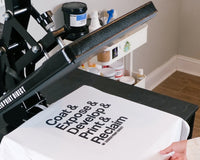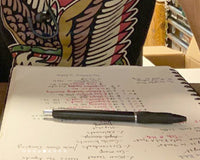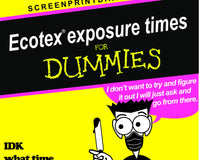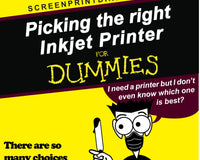So we really don't have A through Z but we covered every letter we could.
Like everything in life, there is specific lingo that pertains to a particular topic. In soccer, you have terms like pk, striker, nutmeg, etc. and screen printing is no different. We have some random words that you might hear in a shop or see online...micros, capillary film, and vellum OH MY!
Let's dive into the world of screen printing lingo and have you talkin' like a pro.
A
Artwork – This is going to be the text or image that you are going to be printing.
AI – Adobe Illustrator is a vectorizing program used by graphic artist to scale images without losing detail.
Automatic – Term used for an automatized silkscreen press, normally found in mid to large print shops.
All heads down – A press that can print in registration in any order or position.
B
Bitmap – A style of image used to make a halftone. It will be a series of small dots that are called pixels.
Block Out – A product used when covering pin holes or an open area of a screen.
Burn – Exposing a screen and the emulsion using a light source.
Butt Registration – When you align artwork with one color up against another color without any gaps in between.
C
CMYK – Four color process that allows you to print full color images with (Cyan, Magenta, Yellow, and Black)
Capillary Film – Another type of emulsion that is applied by the sheet, not a liquid emulsion.
Choke – Reducing the thickness of your art to make sure there are no colors overlapping.
Cure – A term used to ensure that your ink is fully dry.
D
Discharge Ink – This is a water-based ink that when mixed with a discharge activator have a chemical reaction that makes it possible to remove the dye from a cotton shirt and replace the color with the ink color you are printing.
Durometer – The blade density of your screen printing squeegee.
Dye Migration – A problem commonly found when printing white or lighter color inks on polyester garments. For example on a red, you will see the red dyes migrating into the white ink post curing.
DPI – Type of resolution that measures “Dots Per Inch” this refers to how many dots you have in each 1 square inch.
E
Emulsion – Photosensitive chemical or sheet that you apply to a screen to make your stencil.
Exposure – Term used for exposing your screen coated with emulsion to some sort of light source.
Emulsion Remover – Chemical used to remove your emulsion/ stencil from your screen when you are ready to clean them off.
Exposure Calculator – Tool used to help estimate how long you should expose/ burn your screen for.
F
Fibrillation – When garment fibers get pulled up with the ink being printed making your print raise up and look fuzzy.
Flashing – Applying heat to what you are printing to get the top layer of ink to gel so it can be handled and printed on top of.
Flood – Term used for spreading ink across your screen without printing it through the mesh.
Fisheye – Small circle shape is formed in the emulsion drying process when your emulsion is contaminated.
G
Ghost Image – When your mesh gets stained with the ink you were previously printing.
Gap Registration – This is when you are printing multiple colors, but they do not touch like they would in “Butt Registration”.
Gel – Term used for plastisol inks when they get to a semi-cured state in which they can be handled without smearing.
H
Halftone – Similar to bitmap, this is the process of making an image with the use of dots.
High Density – Prints that are done with specialty inks that raise above the garment. (there is also special high-density emulsions that are used for these types of prints).
High Opacity – Inks that have good bold color and coverage on darker garments. They normally do not require the use of an underbase.
Haze Remover – Chemical used for removing ghost/ haze from your screen mesh.
High Viscosity – Screen Printing emulsion that is high viscosity or HV creates a thicker stencil allowing you to lay down more ink with each push/pull such as Ecotex® Textile Red High Viscosity Screen Printing Emulsion and Ecotex® Textile Blue High Viscosity Screen Printing Emulsion.
I
Inkjet Film – A semi-translucent plastic film used with an Inkjet printer to create a film positive.
Ink Degradant – Chemical used prior to reclaiming to remove ink from your screen printing screens such as Ecotex® Plastisol Press Wash and Water Based Press Wash.
Image area – This is where your artwork will be located on your screen.
J
JPEG – A standard file type, which has been flattened. This is normally very low quality.
L
Low Bleed – Type of ink that is made specially to help prevent color migration or bleeding, such as Rapid Cure Plastisol Ink
LPI – Lines per inch are how many lines of dots there are to create halftone dots for exposure.
M
Manual – A manual screen printing press machine that is found in most garages and small print shops
Mesh – Woven material that is adhered to a frame and used for screen printing
Micro Registration – Adjustable hardware that allows you to fine tune your registration on your press.
Misprint – Term used to describe a mess up/garment that cannot be sold.
N
Newton – A unit of measurement used for measuring tension on screen mesh.
O
Off Contact – The gap between the screen and your shirt platen
Opacity – The coverage of ink on a garment. You would want light colored inks to have a high opacity, so you get a nice bold color on a dark garment.
Overexposed – when you expose/ burn your screen for a longer amount of time than needed. This makes it difficult to develop your artwork.
Over Flood – putting too much pressure while spreading ink. This can cause the sharp lines in your print to become blurry.
P
Platen – Or pallet is the surface that you put your garment on during the print job.
Photopolymer Emulsion – A type of emulsion that exposes relatively quickly and is ready to use.
Post Hardening – Also known as post exposing, leaving your screen out in the sun, or exposing it a second time around to help harden the stencil.
Proof – An example you provide the customer, so they know what their order is going to look like.
R
Reclaiming – Cleaning your screens of ink and emulsion when you are finished printing with them.
Registration – Aligning your artwork making sure that it is nice and straight.
Roller Frames – Frames that you can re-tention yourself
Reducers – Chemical that you can add to your inks to help reduce its viscosity/thickness, such as Ecotex® Curable Reducer.
S
Scoop Coater – Screen printing scoop coater is a tool used to apply your emulsion to your screens.
Scorching – Burning a shirt or garment due to an excessive flash time or curing time.
Screen Printing Frames – Frame made from wood or aluminum with a fabric mesh that is used to make your stencils.
Squeegee – A screen printing squeegee is normally made with a wooden handle. This tool is used to spread ink across your screen for printing.
T
Tension – How tight the mesh is on your screens; this is measured in Newtons.
Tack – This is the glue that you use to keep your garment in place while you print. Check out our screen printing pallet adhesive here: Ecotex® Super Tack.
Trap – Stroke given to artwork to help reduce misaligned registration.
U
Underbase – Layer of ink that is used on darker garments to help colors printed on top of it maintain their color. It is usually a white ink. Check out our white underbase screen printing plastisol ink here: Rapid Cure Underbase White Plastisol Ink
Under Expose – When you do not expose/ burn your screen for the proper amount of time and it causes your stencil to wash off completely.
V
Vector – Type of art file that allows you to expand or reduce sizing without losing details or pixelating the art.
Vellum – Semi-translucent paper that can be used in a laser printer to make your film positives, this is an alternative to inkjet film.
Viscosity – Term used to describe the thickness or thinness of an ink.
W
Wet on Wet – The ability to print each color one after the other without having to flash in between.
Wash Test – Make sure that after you print a garment it goes through a washing machine or simulated washing to see how the product will hold up
Washout Booth – An industrial sink. It is used after exposing your screen to wash out emulsion and for all around clean up.
Water Based Ink – Ink that dyes the garment and becomes part of the fabric threads.
Well there you have it printers, there is a lot of lingo to learn but once you know it, you know it!
Let's Talk
Remember, we are here to help! Drop a comment below or email our support team at info@screenprintdirect.com








1 comment
anita kiewra
Do you have a pdf of this I can drop in my google classrom for our studio?